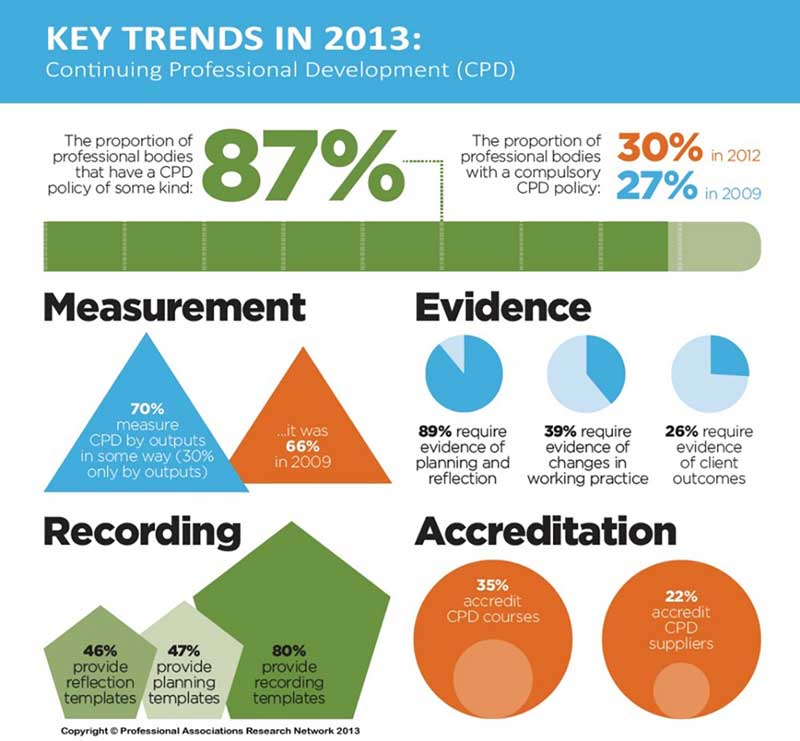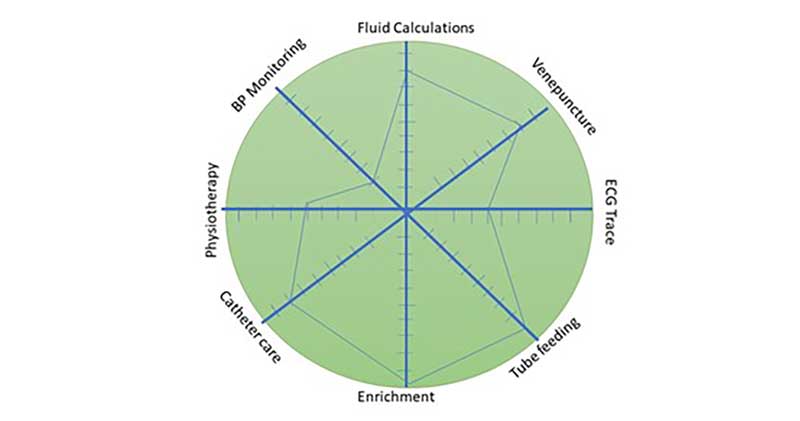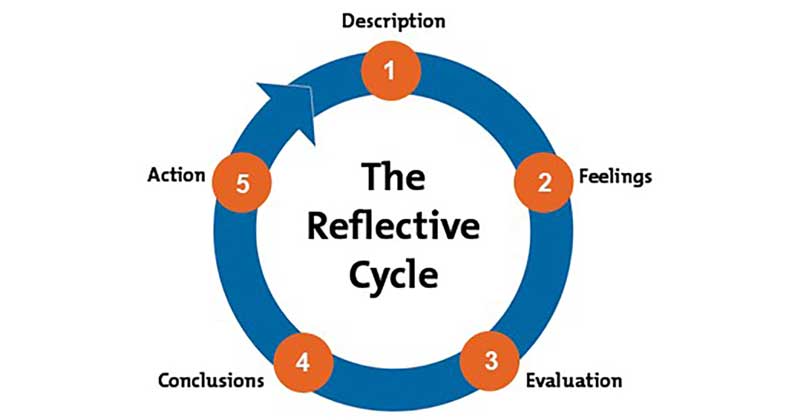Continuing Professional Development (CPD) is a concept we are all well accustomed to, with the first 500 RVNs being audited in 20091.
Many CPD definitions are available on countless websites and other sources. One the author is particularly fond of is from CPDUK2 – “CPD is the holistic commitment of professionals towards the enhancement of personal skills and proficiency throughout their careers” – as it reflects her own practice, in which she seeks opportunities to develop herself each day.
Getting with the times
Let us understand firstly that the veterinary profession isn’t the only one to set standard requirements for CPD fulfilment to maintain registration.
The Professional Associations Research Network produced an infographic (Figure 1)3 to reflect results of research carried out among wider professionals internationally in 2013.

The RCVS made CPD mandatory for veterinary surgeons after a council decision in 20054 that was reflective of the 27% of professional bodies having compulsory CPD in 2009. However, it is only in 2022 that the RCVS made it compulsory to carry out reflective practice, which reflects current opinion by representatives of the RCVS that the profession is behind others of a comparable function5.
Outcome-based CPD
Throughout 2016-18, the RCVS conducted a consultation and pilot to review the CPD requirements, and assess the profession’s new proposed CPD platform.
The emphasis of such change was on analysing training needs, planning to fill gaps and reflecting on any activities undertaken. The move sought to encourage practitioners to proactively seek to develop their own practice, not to just meet hours set within CPD policy.
1CPD6 replaced the online Professional Development Record from 27 January 2020, and was made available with website access or downloadable as an app.
The new platform allows you to record notes and reflect on your learning to determine whether the activity has been effective, with any acquired learning being implemented in practice or of course where, to the contrary, further planning to meet objectives may be necessary.
Sargeant et al7 discussed the concept of using an outcome-based CPD system to facilitate quality improvement from a competency-based perspective. With this being the consideration of the veterinary sector, the outcome of patient care is one of the main considerations to the outcomes of CPD planning and activity.
With this on the agenda for the consultation, RCVS senior vice-president Stephen May was quoted as saying: “…CPD activities focused on outcomes encourage professionals to reflect on what they have learned, how they will apply their learning and how it will improve their practice…”8.
Outcome-based CPD holds mutually beneficial advantages.
Individuals can analyse their own skill gaps and plan to fill those gaps, known as upskilling, which promotes job satisfaction motivated by a recognition of achievement and self-value.
The Chartered Institute of Personnel and Development9 describes a full CPD cycle. It also makes reference to promoting well-being, explained as “a state of contentment, which allows an employee to flourish and achieve their full potential for the benefit of themselves and their organisations”10, which reflects the aforementioned upskilling notion well.
Staff should feel comfortable approaching management to discuss any CPD requirements or desires, and when considering requests, management should consider the bigger picture.
By setting clear organisational objectives, employers can analyse an overall team’s skills in meeting these objectives and by investing in training of identified individuals to fill such gaps with specific, measurable, achievable, realistic and timely (SMART)11 goals. In doing so, they will retain staff and gain skilled workers without the need of lengthy recruitment processes. We shouldn’t, of course, forget regular performance reviews, formal appraisals or, indeed, further coaching may all be necessary to support success.
Planning methods
A commonly used method of self-reflection is the SWOT analysis; identifying your strengths, weaknesses, opportunities and threats. This is used in many professions as a means of thought process to determine any intrinsic and extrinsic factors to manage through personal development; however, it does not immediately offer solutions, only highlights the desires of individuals. Further information and a free worksheet are available at Mind Tools12.
The author’s favourite part of personal self-reflection activity is the Self-Reflective Wheel (Figure 2). This works well with any professional skills or may even be used to illustrate work-life balance to assist as a life coach tool.

The author has chosen the area of nursing care to devise this example – you can use less or more spokes – with each spoke being an area for reflection.
How confident/competent are you? What do you do more/less of? What would you like to do more/less of? Determine on the scale of 1 to 10 where you sit, then plot from one spoke to the next. This illustrates the parts you need to work on to gain a balanced “inner wheel”.
So, from the worked example, the author may wish to plan CPD on ECG, BP monitoring and physiotherapy as a starting point to feel more confident and deliver the best care to in-patients in her care. Harvey-Lloyd13 discusses the tool and its application further, acknowledging its usefulness in the context of education.
Types of CPD
Professional development is not about taking on a two to three-year postgraduate certificate, unless this achieves objectives, but more about project managing requirements versus desires, whether activities be general learning about products and equipment, brushing up on knowledge to maintain competency in an area or learning new skills for a new service being introduced. Table 1 lists CPD activity types.
| Table 1. Type of CPD. Adapted from RCVS 1CPD App and RCVS14 | ||
|---|---|---|
| Formal | Workplace | Self-directed |
| Clinical skills lab | Case discussion | Preparing for a new lecture |
| Conference | Clinical audit | Preparing a paper |
| Course | In-house training | Research |
| Distance learning – formal | Peer feedback | Veterinary reading, including medical journals and other cross-context reading (for example, animal welfare) |
| Distance learning – other | Significant event analysis | |
| Distance learning – webinar | Work-based observation | |
| External qualification | Secondment | |
| Seminar | Shadowing or being mentored | |
| Workshop | Relevant to your position – for example, employment law, or health and safety | |
| Attendance of industry meetings or briefings | ||
Webinars and seminars
Lockdown in the current pandemic has provided CPD in abundance.
Ask yourself does it fulfil my objectives? A webinar on fluid therapy is informative, but will you learn any more than you already know to apply it to general practice?
Ask yourself what audience is it aimed at? The author finds seminars or webinars aimed at general nursing practice just confirms current knowledge, therefore often seeks those with a veterinary surgeon focus.
The content may be out of remit; however, a broader understanding of the RVN role is gained and new knowledge, so can be used to support colleagues in practice.
The author’s general advice is if it is up to an hour and recorded then seek the recorded option over the live, unless you have a keen interest and would like to pose questions to the speaker. That way you can play back when it is convenient, you have less chance of distraction and, if you are distracted, you can pause and come back to it at your leisure.
Webinars are usually free, which is a huge advantage; however, ask yourself:
- Is it sponsored?
- Is the speaker credible?
- Does a risk exist of speaker bias to the presentation?
The latter often concludes that further research to critically analyse the information as a follow-up is required, which, of course, means more CPD and learning.
Particularly rewarding are presentations where the speaker provides an extra reading list or signposts you to further resources.
Accredited courses
Accredited courses are those with structure. They are planned to include learning outcomes that are advertised before booking, so you can gauge whether the content meets your requirements. They include an assessment to check that learning has taken place, which helps reflection and serves objectives further. The disadvantage is delegate fees are usually applicable. Make sure you consider if a return will occur with applied knowledge.
Accredited courses conclude with a certificate to demonstrate not only attendance, but to confirm a passed assessment.
Recording
Some webinars and seminars may offer a certificate of attendance. A requirement for such evidence no longer exists; however, you can upload files as evidence, which may include certificates, notes, screenshots (please check copyright), attendance email confirmations and so on.
Providers are recognising the importance of auditable CPD, with some providing a record function so, once logged in, you can keep a record of the CPD you have undertaken on their platform, which can be referred to in your RCVS CPD log, be printed, or screenshotted and attached.
Reflection
The RCVS15 offers some great advice on reflective practice. It emphasises that reflection on CPD activity does not have to be a lengthy, time-consuming process, nor does it have to be timely to the activity; however, its impact should be relevant to a person’s professional development for his or her current position(s) or role(s).
If, like the author, you appreciate having a template for train of thought then Gibbs’ Reflective Cycle (Figure 3) is a good method for reflecting. It takes into consideration your feelings while performing and afterwards to assist reflection on not only competency, but also confidence, which the author thinks is very important when considering regulatory factors; for example, accepting delegation.
The cycle is explained further by Mind Tools16.

Summary
The requirement of CPD is mandatory for an individual practitioner to remain on the RCVS register. The introduction of an outcome-based CPD cycle can only be of benefit to the profession as RVNs become empowered and motivated, knowing their own personal development will go towards the inner workings of practice and industry.
Nurses will improve on their own skills, gain confidence and competency, and improve services and care, while, furthermore, being recognised by employers as contributing to the bigger picture in meeting set objectives.
* UPDATED 22/07/2022

Leave a Reply